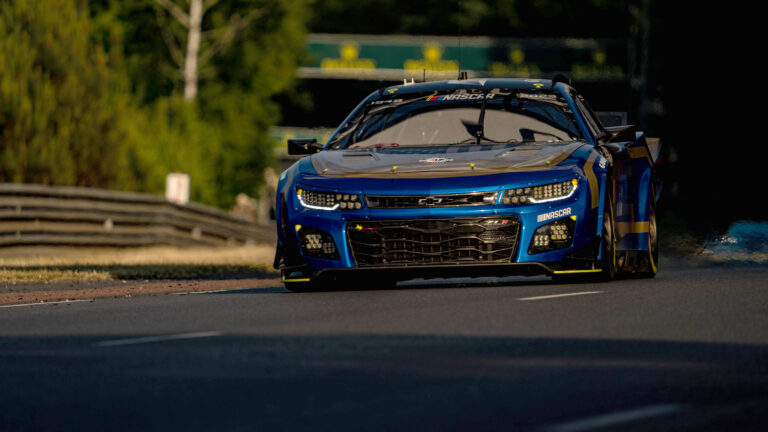The Garage 56 slot at Le Mans has garnered some interesting entries over the years, from the DeltaWing and ZEOD to the impressive efforts of quadruple amputee racer Frédéric Sausset in 2016. The year 2023, however, ranks as the most spectacular yet, as the thunder of NASCAR engulfed the event, creating an instant fan favorite.
There was no shortage of naysayers when the project was announced; after all, what could a bunch of stock car racers know about endurance racing? As it turned out, quite a lot. When NASCAR announced the project in 2022, and the team assembled for the undertaking, it was clear this wasn’t to be a half-hearted effort. NASCAR R&D would work in conjunction with chassis supplier Dallara, alongside GM and Hendrick Motorsports (HMS), with legendary crew chief Chad Knaus heading up the project from the latter’s corner.
The driver line-up, meanwhile, mixed the endurance experience of Mike Rockenfeller with stock car royalty Jimmie Johnson and the well-rounded skill of F1 champion Jenson Button. The NASCAR Cup Gen 7 platform, more akin to a GT3 car than a stock car of old, was what made the whole undertaking possible.
Amazingly, the idea of running a Cup car in la Sarthe was floated before the first oval prototype had even turned a wheel. “Right before the actual competitive debut of Next Gen, this car was already being designed,” admits Brandon Thomas, VP of vehicle design at NASCAR. “In the first third of last season [2022], while we were fixing all these little issues with Next Gen, getting up to speed and getting the teams used to the new car platform, every couple of days or so me and guys at Dallara would spend an hour or two on Webex discussing this project.”
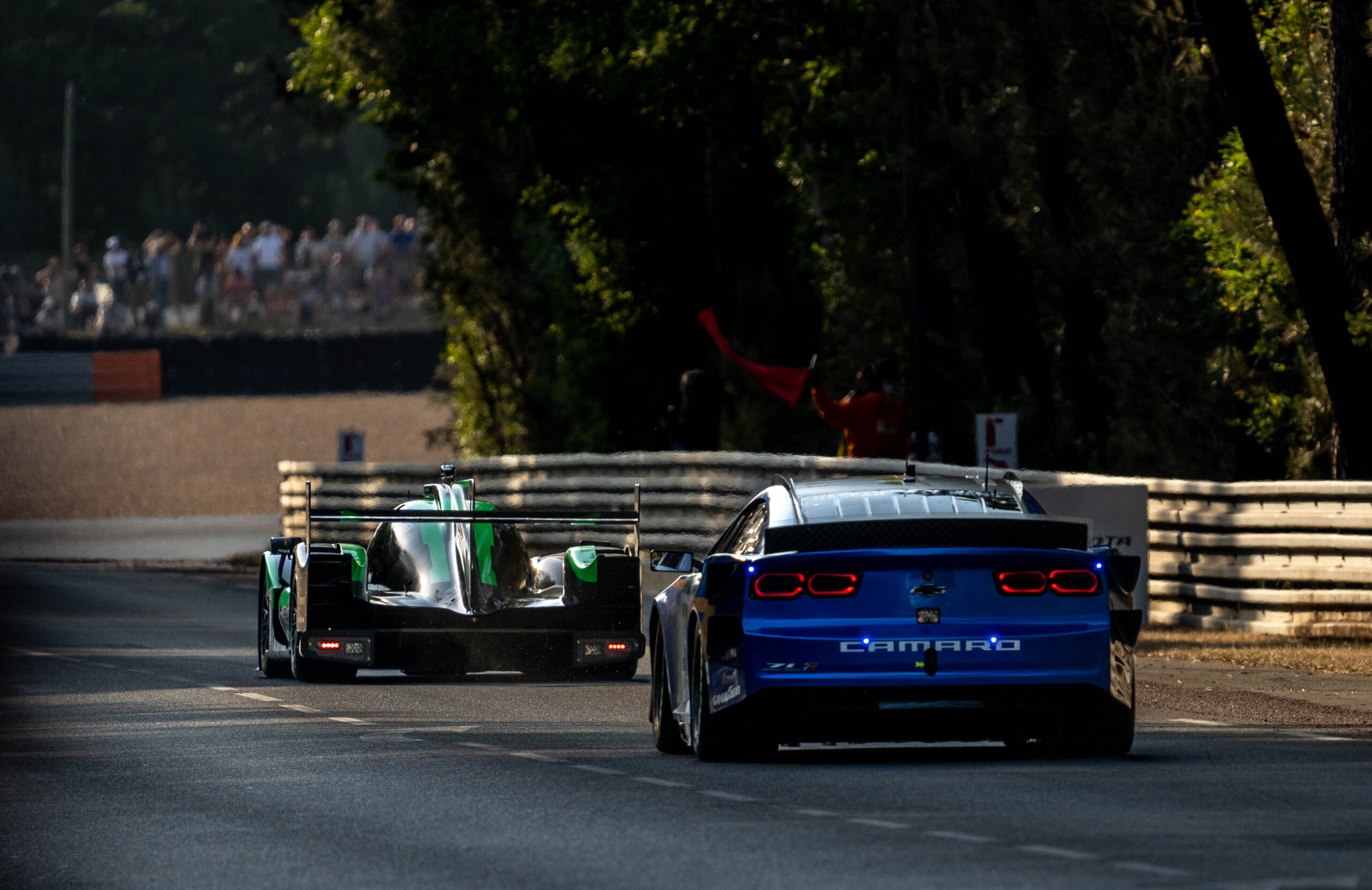
The result was a leaner, meaner stock car. “We just said, okay, now that we don’t have to race Talladega with a 40-car field with everybody running into each other, let’s go to a 62-car field, and maybe run into one or two here or there, and run at night and in the rain. Then it was gloves off. How much weight can we save? How much tire performance can we package? What can we do for motor performance?” Thomas recalls.
Weight watchers
A standard Cup car weighs in at a mandated 3,200 lb (1,451kg), while the minimum weight in the GTE class, the performance yardstick NASCAR was working to, is 1,254kg. To get the Garage 56 machine in the performance window while keeping the tires alive would require it to go on a diet. Impressively, the team managed to take around 225kg out of it.
According to Jessica Hook, a design engineer from HMS involved in the project, the weight saving was all the more impressive as not only did the car come in just marginally heavier than a regular GTE, but considerable weight also had to be added in the form of a full data acquisition harness, headlights and other ancillaries, not to mention the additional aero devices. The chassis design is essentially the same as the standard Gen 7, beyond the location of the fuel cell, which has been moved to the center of the car.
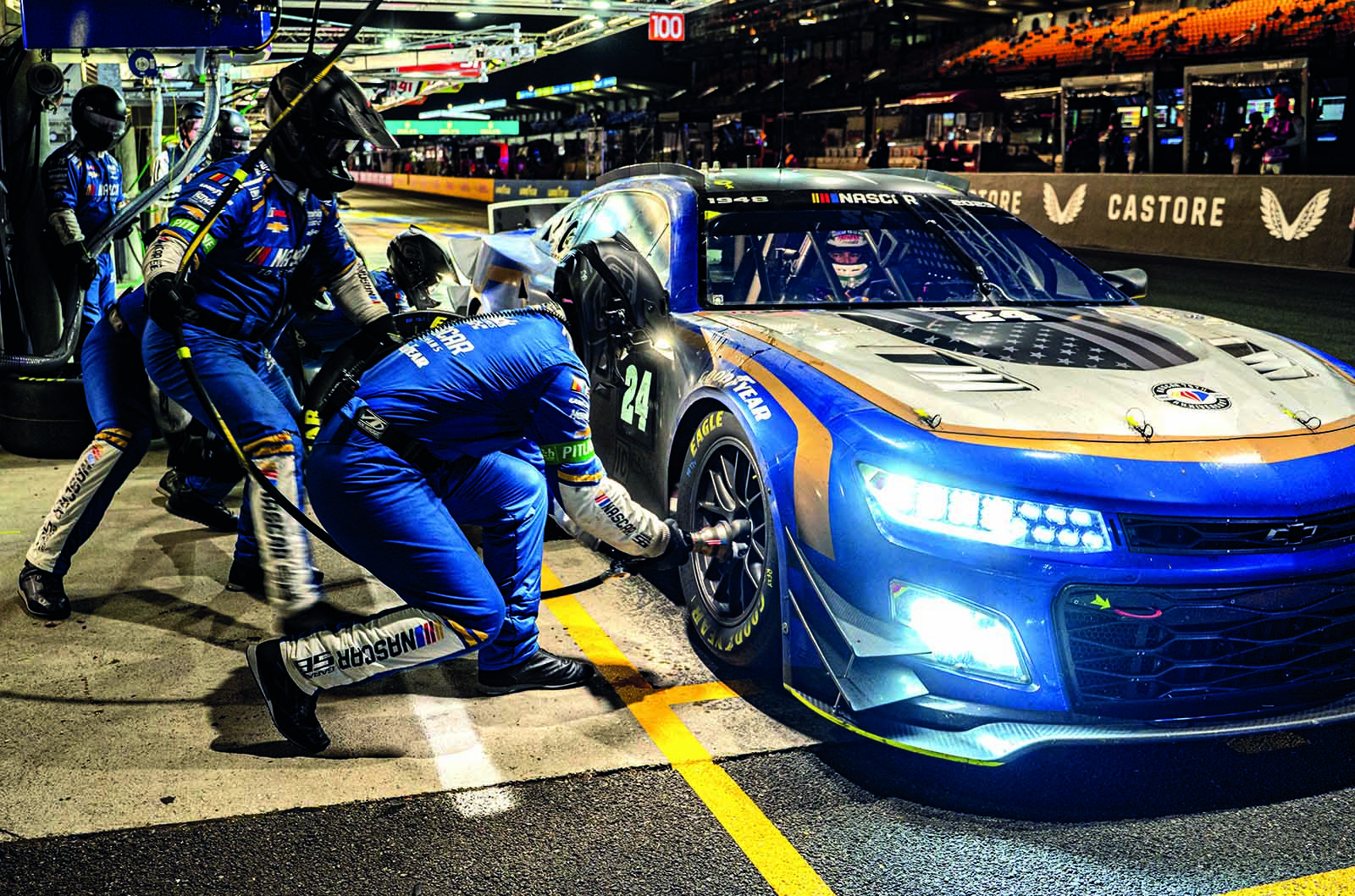
The existing structure was simulated through the FIA crash tests to ensure it met the requirement for GTE racing, which it did comfortably. The moving of the fuel cell also brought weight distribution benefits: “Honestly, the fuel cell is now where it ought to be [in Cup],” muses Knaus.
Hook, who has a background in sportscars prior to NASCAR, also observes that in the mandatory recovery test at Le Mans, “We picked up our car and it was the most level I’ve ever seen it. I thought, yeah, they nailed the CG.”
Hook notes that the majority of weight savings were achieved via the substitution of parts that are mandated under Cup rules with lighter options. For example, the suspension uprights were revised and a switch to carbon-carbon brakes netted a considerable gain over the stock iron productions. However, intrinsically, the parts are still NASCAR. “Really, it’s not much different,” says Hook, “to the point where we had to make sure to mark the components for the G56 as they look so similar to the regular parts, because we’d be in big trouble if we showed up with them to the racetrack. They’re just like lighter cousin counterparts.”
Aero efficiency
The main demand for the aerodynamic team – headed up by NASCAR’s Eric Jacuzzi – was performance, says Thomas: “How much performance can we get out of this without it looking like a GT car?” He admits that a rear wing, rather than the traditional spoiler, was considered, but it was unanimously decided that the addition would detract from the stock car vibe. Dallara and NASCAR developed the initial aerodynamic model of the car, focusing their attention on a revised underbody, with HMS then getting stuck into the detail design.

“We worked basically off of the Gen 7 body in CFD, and then we started to morph it from there,” says Knaus. “Then as we went to the wind tunnel, we started to validate everything and just iterated from there. There’s a lot that’s different [from the Cup car]; it’s very subtle, but impactful.”
One area that saw considerable modification from Cup spec was the engine cooling and inlet. In Cup, all the air is fed from the lower half of the front fender, but this is not so in the G56, where the inlet is ducted from the top of the grille and the cooling from below. “We wanted to isolate between the engine cooling and the engine intake,” explains Knaus. “We felt like that was important and that was a big driver in the front.” There was also an aesthetic element to the revisions. “We wanted to add styling cues to be quite frank, to look more like a production Camaro, which it does; it looks pretty close.”
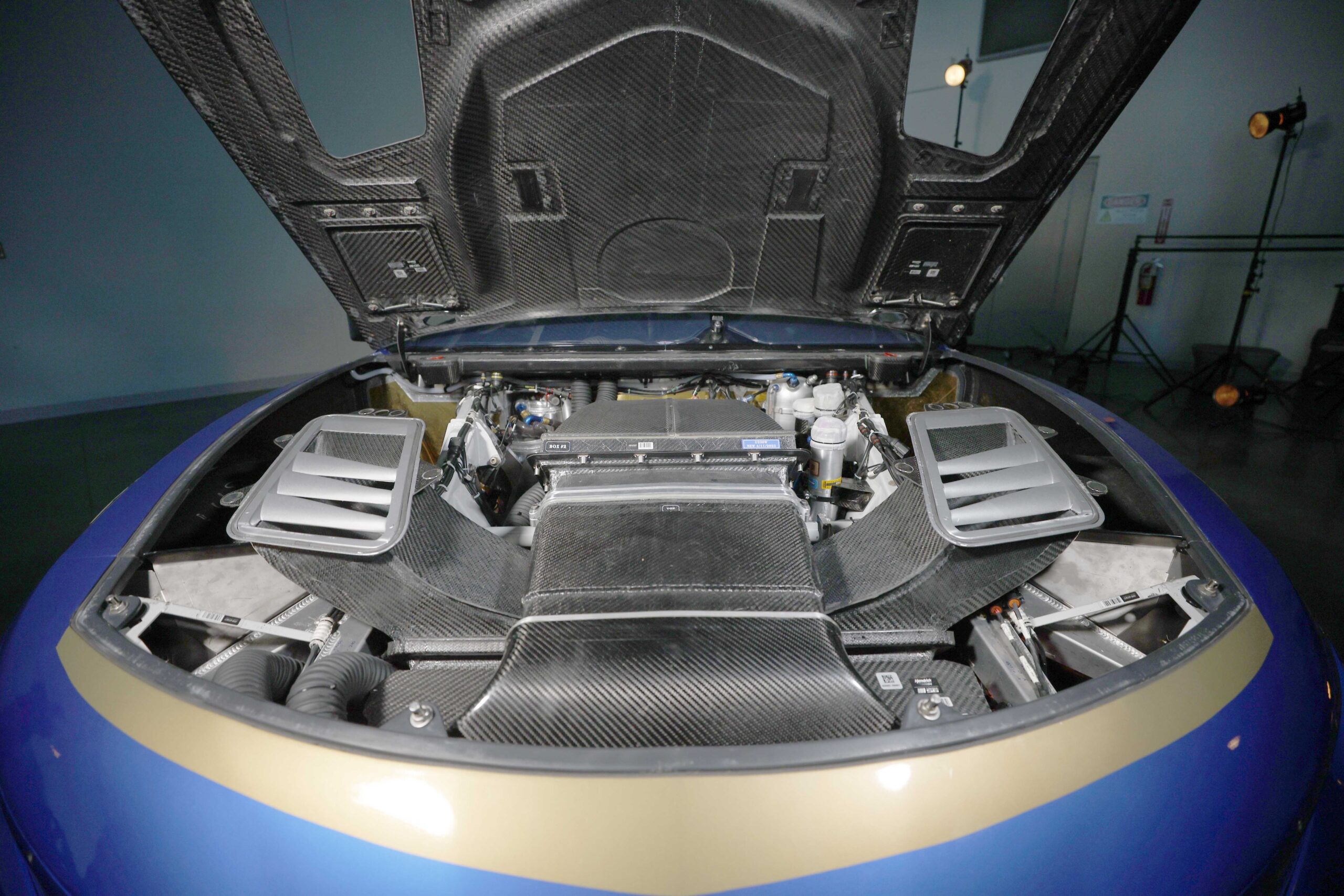
Pushrod power
NASCAR currently uses 358 cubic inch, (5.9-liter) pushrod V8s with cast-iron blocks and alloy heads, and this base engine was retained for the G56. Notably, it has been a decade and a half since a pushrod V8 ran at Le Mans (the Saleen S7-R GT1 with a Ford Windsor-based engine)! According to Knaus, an LS-based engine was considered, which would carry over from GM’s other sportscar projects, but ultimately the team stayed close to its stock car roots. Ford, GM and Toyota all use bespoke blocks developed purely for racing; in the case of Chevy, its Cup engines (as well as Xfinity and Truck motors) are based around the R07 architecture, introduced in 2007 and replacing the SB2 (small block 2).
The engine has undergone multiple iterations and is now technically an R07.3. Scott Meesters, director of special projects at Earnhardt Childress Racing (ECR) and responsible for the Garage 56 engine development project, notes, “The .3 only denotes the block version; the heads are actually .11 heads. The block has gotten some serious work done to it [over the years] as far as lightweighting, changing some of the sealing surfaces and making it a little more user-friendly in some areas. That work has been done almost 100% by General Motors. The block work combined with the cylinder head development has shaved off some decent weight. It’s a nice little package for a cast-iron block.”
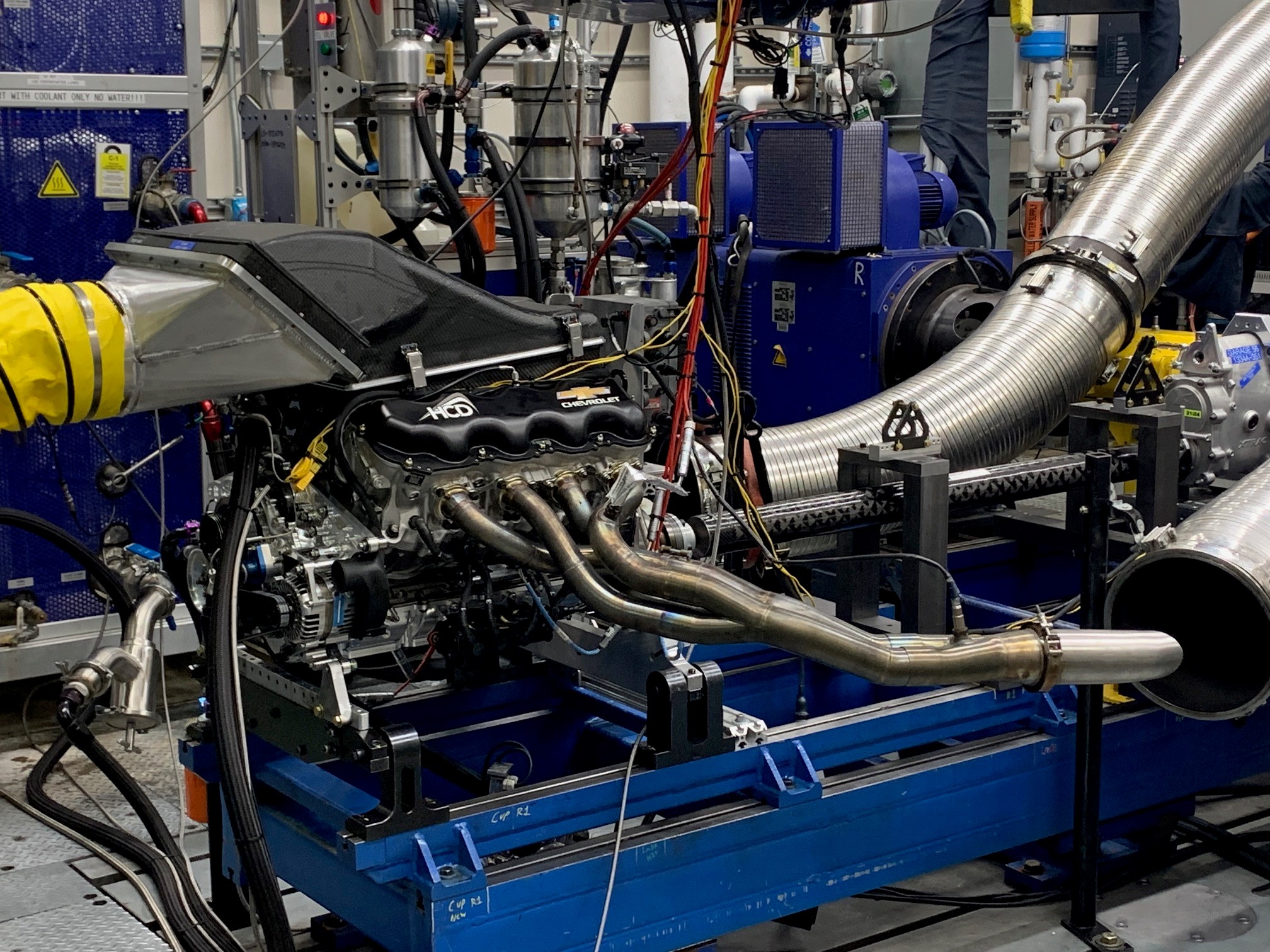
The 90° V8 is a robust unit, though performance in Cup guise is severely constrained by NASCAR’s insistence on the use of a tapered spacer in the inlet at all tracks, trimming power to a maximum of 670bhp (on short tracks). In their heyday, before the introduction of RPM limits and tapered spacers, similar engines were running over 900bhp at non-restrictor-plate (the precursor to the tapered spacer) tracks.
Some modifications were required to go endurance racing, as Meesters explains: “It is mainly designed for turning left, for use on ovals. So the one thing that was at the top of our minds was tailoring the engine to just do road courses.” Furthermore, where a Cup motor will run for around 2,400km before it is rebuilt, for Le Mans this needed to be more than doubled to around 5,600km.
To meet these demands, modifications were made to various elements, including the lubrication system and valvetrain. “The oil volume is smaller than we use in NASCAR, more comparable to what we see in our sportscar engines,” says Meesters, but other than that, “There weren’t any huge architecture changes: we didn’t change the oil pan, there was a small change to the oil pump in how the pressure stage works, but even that is something we’ve done in the past.”
The stock Cup crank, bearings and conrods are retained, the only change being tighter bearing tolerances, made possible thanks to the engine being preheated before fire up, something that doesn’t happen in Cup.
The piston, meanwhile, is bespoke to the Garage 56 car. “It’s a blend of some of our Cup technology and some of our previous sportscar technology,” notes Meesters, adding, “The engine obviously has to go through the demands of a 24-hour race: we erred on the side of safety versus using our Cup piston.” The ring pack, for example, is more conservative than that used in Cup. “I opted to ditch the Cup ring pack and go back to our old DPI ring pack, which is a 0.7, 0.8, 3mm [two compression rings and an oil control ring] package.”
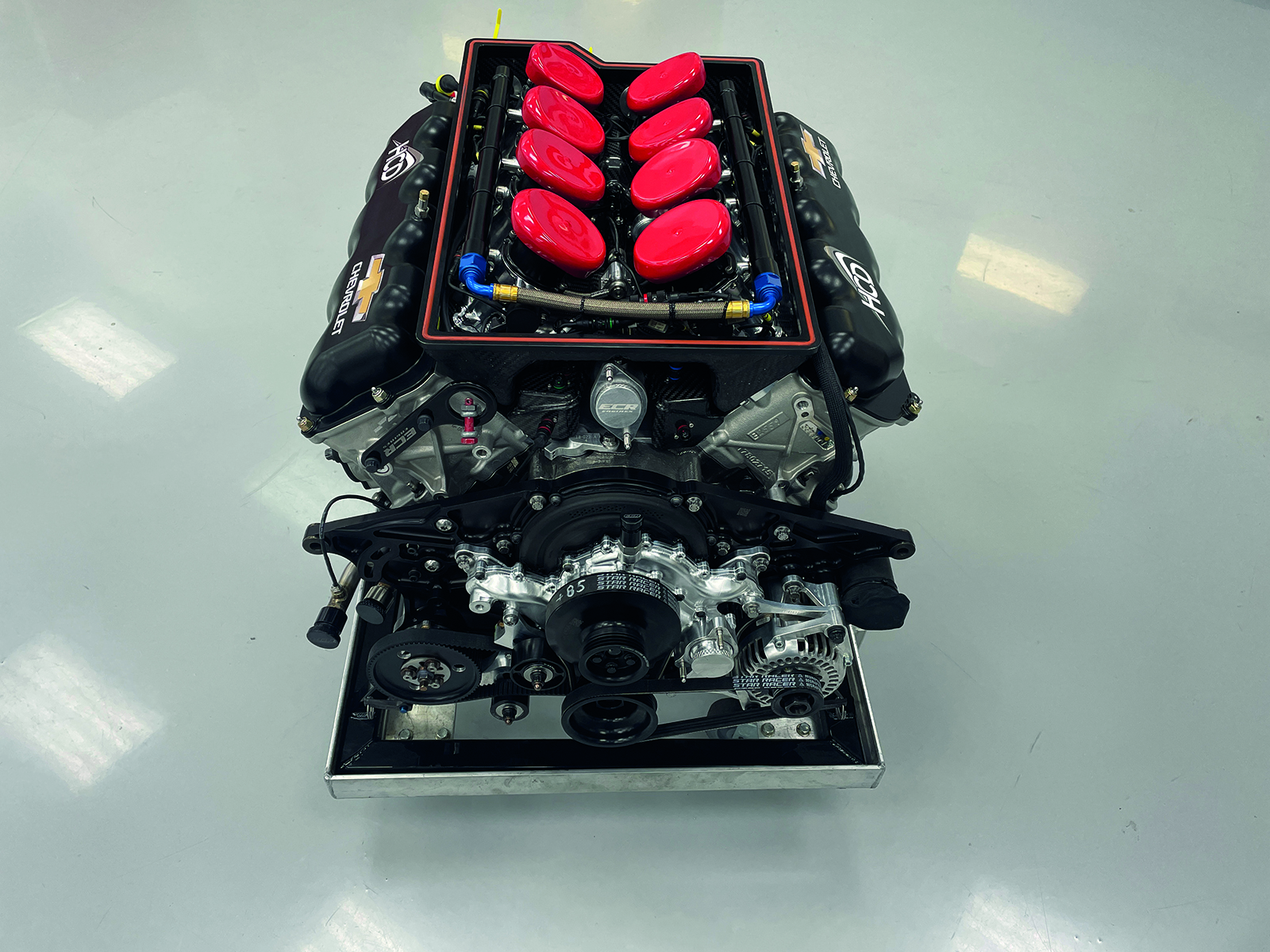
One area that proved challenging for the engine development team was the valvetrain. The duty cycle of an engine at Le Mans is a combination of that seen on NASCAR road courses and ovals; plenty of running at wide open throttle, but interspersed with some low-speed corners (such as Arnage). To this end, a bespoke cam profile was developed, mixing elements of GM’s experience in sportscars and Cup. The rockers are steel productions, with a very high ratio. “We wanted to use the rocker that we use in Cup. We’ve put a lot of design work into it and are proud of it, so we wanted to carry that over. What we then did was reverse engineer the camshaft for that rocker ratio, which is vastly larger than what we used to run in sportscar,” Meesters explains.
While there were no issues with the cam and rockers, the pushrod-rocker interface did cause concern. “Honestly, I had underestimated that interface [between the rod and rocker],” admits Meesters. “The previous sportscar engine was pushrod-based and we rarely had any issue with that interface. We didn’t expect there to be any issue with going forward with this project. But something got thrown at us and it had more of an effect than we thought then. That was the fuel.”
The fuel in question is the Total-produced 100% sustainable gasoline made from agricultural waste and used across the WEC. Meesters says the team has found the WEC spec led to far greater levels of fuel dilution in the oil than its NASCAR fuel. Fortunately, the only place this manifested as a problem was the pushrod-rocker interface. Fortunately, decades of developing pushrod V8s meant the team had more robust pushrod designs to fall back on, which, when combined with other subtle revisions, cured the issues.
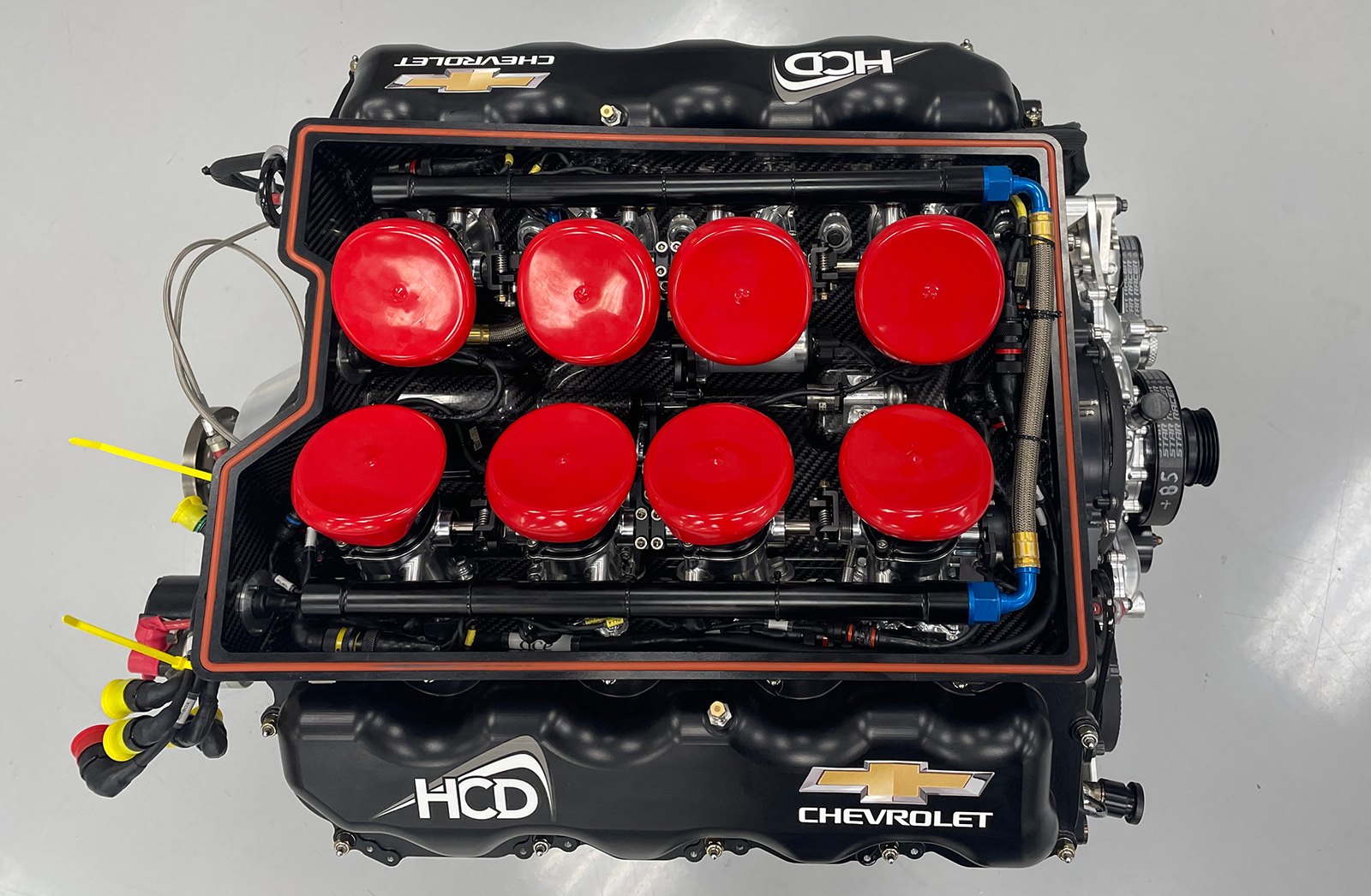
ECR opted to run a Bosch MS 7.4 ECU, rather than the spec McLaren unit used in Cup; the former is also used on Chevy’s Corvette C8.R GTD and GTE cars. “The actual engine electronics architecture on the Garage 56 car is very close to what is in the Corvette C8.R. So we took a lot of those learnings and transferred them over, which let us hit the ground running,” states Peter Serran, who leads the GM global propulsion team at Corvette Racing. The Bosch ECU takes care of traction control, something stock cars certainly do not feature. The traction control program was based on ideas ECR had developed during its sportscar days but reworked to operate with the latest hardware.
Given the time constraints of the project, Meesters explains, “We looked at the base code traction control and made some modifications to get where we want it to go. It’s not a mirror image of what we had before but it’s able to do the job we need it to do.” Transmission control is also handled by the ECU.
The car runs a NASCAR spec Xtrac P1334 transmission retrofitted with an electronically actuated paddleshift system rather than a manual sequential. The ratios inside the box are similar to those used in Cup (where various gearset combinations are available to suit different tracks) but mixed and matched to suit the demands of Le Mans. “All we did was we ran our road course cluster set that we would run at Watkins Glen, etc, and we put a taller bevel in it, so this basically has the Daytona Talladega speedway bevel gear in it, because we’re doing 190mph [306km/h] at Le Mans. But it’s basically a road course box,” says Thomas.
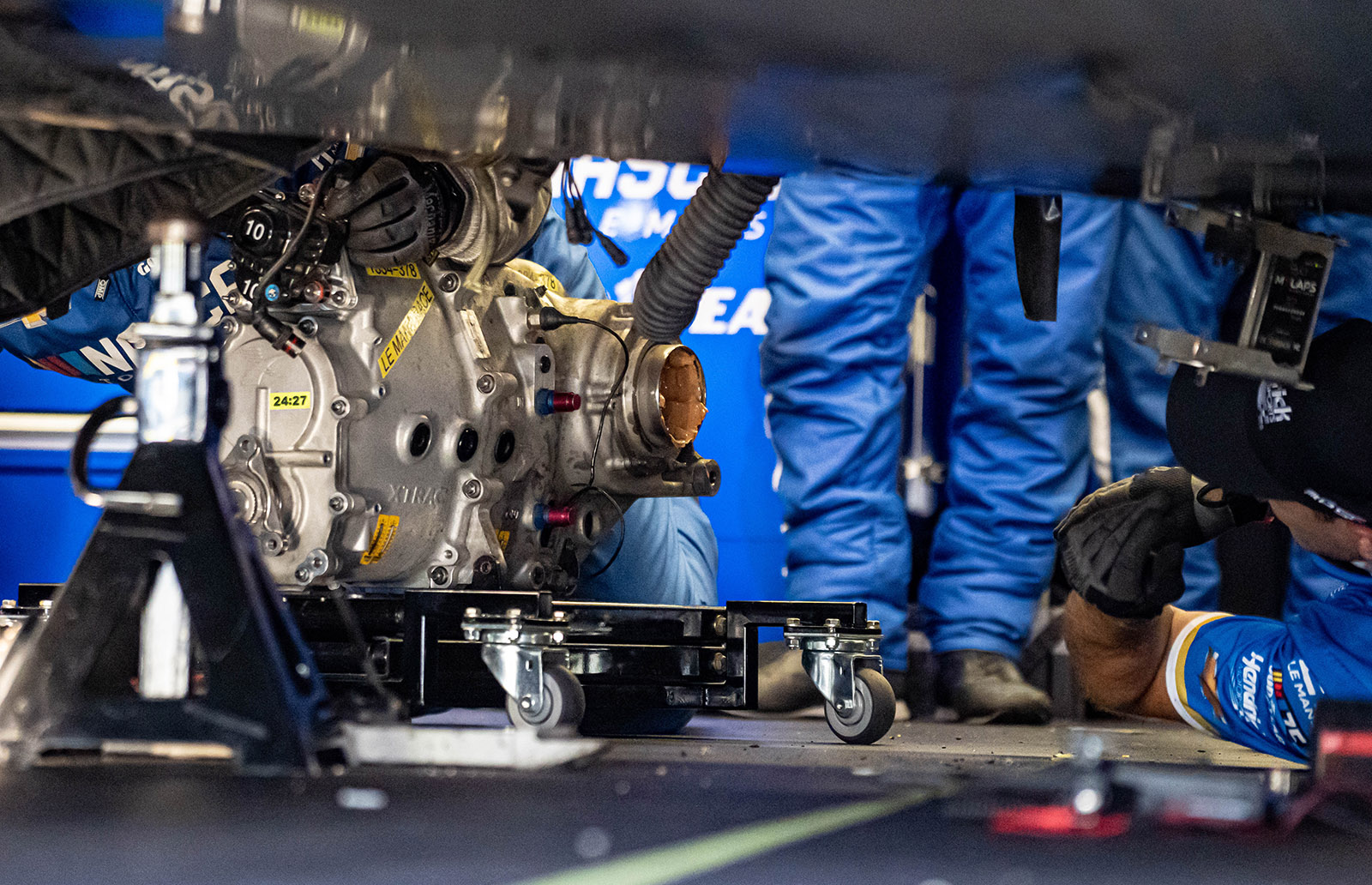
At one point, the addition of a hybrid system was considered, but later ditched. The engine calibration work, when coupled with modifications that are not permitted in NASCAR, such as individual inlet runners (rather than the standard inlet manifold with plenum) combined with two throttle bodies, resulted in a much more responsive engine than in Cup form. The reliability work also paid dividends and throughout Le Mans, the team had no reliability troubles; however, the same could not be said of the gearbox.
Trouble struck in the closing quarter of the race. Coming out of Indianapolis on lap 253, driver Jenson Button found he had no gears. As the car rolled into the pits, it was clear the problem was terminal. Normally, it is not permitted to change a box during the race (thanks to Audi’s mid-race trans change antics in 2000), but as Garage 56 is an experimental entry, an exception was made. Following a short conversation between program manager Ben Wright and an ACO official, a couple of text messages were exchanged and permission was given to swap the box. This was not the work of a moment, and it took over an hour for the car to get back on track, but return it did.
Preparation makes perfect
The G56 team’s pre-Le Mans preparatory work was on the money. “I do feel that it was really impressive,” says Knaus. “Our last driver-in-the-loop simulator test, we were running consistently in the 3:54 range. And that’s right where we were when we unloaded.” While some elements were easy to get right, “The track itself, the track surface, the track configuration, all of that, we had to make all of that,” he muses. “The tools that we have with Chevrolet are pretty amazing, from our desktop sim, and how that correlated to our at-track and DIL simulator performance, it was impressive.” 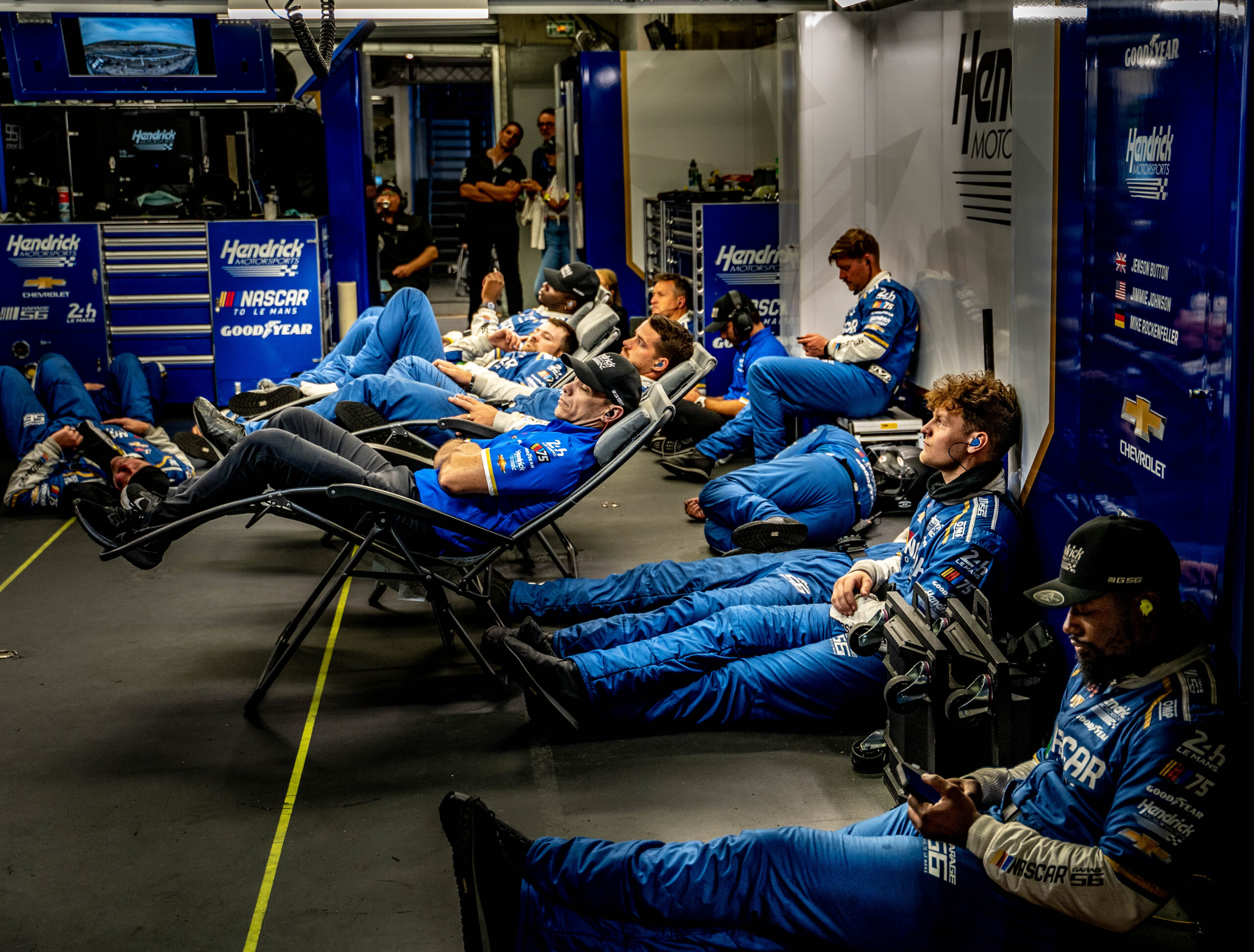
There can be no denying that the entire Garage 56 project was a resounding success, even if the car ended up finishing down in 39th place after its gearbox troubles. Judging by the social media response alone, it eclipsed even Ferrari’s return and victory as a fan favorite. The team also changed a few stereotyped opinions of how NASCAR operates. Not only was the car on the pace (well clear of the GTE field), the pit crew – using traditional manual jacks, no in-built air jacks here – presented as a seasoned endurance squad and the whole operation was the epitome of professionalism.
Despite this, everyone was clearly having a good time, as Knaus confirms. “It was fun. It gave us the ability to get our creative juices flowing again,” he says. “What I’ve probably enjoyed the most is being able to be creative with the car. Going through scrutineering here was probably the easiest technical inspection I’ve ever had in my life. I’m really pleased with the car. “When you look at it, it looks good, it sounds good, it runs well, the drivers are pleased with it. It’s definitely the best NASCAR car ever built to date,” he concludes, proudly.
This article was originally published in the September issue of Professional Motorsport World magazine


